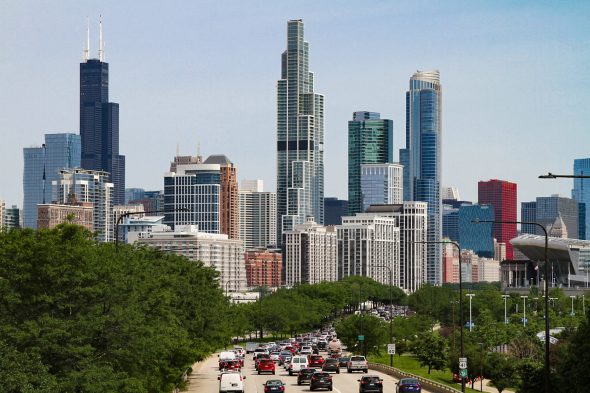Traffic increase contrasts population declines in Illinois, Chicago
While population drops in Illinois and Chicago have gained significant attention in recent years, a growing number of workers and households have led to an increase in road travel, according to a new white paper from the Urban Transportation Center at UIC.
Through an examination of federal data from the last decade covering trends in population, jobs, number of households, labor force participation and income, UIC transportation researchers analyzed how these variables collectively led to more vehicle miles traveled in the state and city during the time in which population has been declining.
The new report, co-authored by Siim Sööt, former director of the center, and P.S. Sriraj, director of the center and research associate professor at UIC, also suggests encouraging economic trends in the Land of Lincoln.
“Increases in employment and a growing number of households lead to the consumption of big-ticket items such as appliances, cars and homes. They counteract a drop in population,” the report states.
From a transportation perspective, the number of jobs, amount of households and figures of household income in a particular region are more important than the number of people, according to the researchers.
Since 2010, Illinois has lost approximately 100,000 residents, but the number of jobs has jumped by nearly 600,000. Given the population developments, the census data and homeownership rates suggest that while large households are leaving, they are being replaced by small households.
Another key determining factor related to travel is household income, they said.
Despite Illinois’ decreasing population, real median household incomes in the state have increased by nearly $12,000 since 2014. Incomes are higher than at any time this millennium and remain above those in Kentucky, Indiana, Iowa, Missouri, Wisconsin, and Michigan, which also shares a border via the Lake Michigan water boundary.
The researchers indicate that household incomes in Illinois initially declined, but have sharply recovered to outpace the incomes in the adjacent states.
For example, in 2018 Illinois’ median household income level was $7,000 ahead of the national median and Wisconsin, and $10,000 higher than Indiana.
Illinois homeownership is near the national level but much higher than in peer states – California, Texas and New York — where rates are pulled down by the largest metropolitan areas.
Together these factors have led to rising numbers of miles traveled on the state’s highways especially in urban areas like Chicago, which indicates that congestion is growing.
“It may reflect more commuting to and from work, more shopping trips, more freight being transported or a host of other transportation needs as jobs increase and households are formed,” they reported.
If labor force participation were to increase in the near future, it would simultaneously stimulate the economy and contribute to more traffic.

